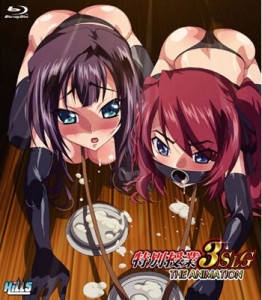Ask John: Why Has Today’s Adult Anime Become So Fetish-Oriented?

I may be wrong, but I don’t think that there is anything with the thematic variation of Cream Lemon or similar in tone to the original Doukyuusei (End of Summer) or Pia Carrot in current pornographic anime. Nowadays, the thematic of erotic anime seems repetitive, fetish focused and rarely experimental, and many of them seem to focus in hardcore fetishes, regularly going as graphic as possible with cheaper production values than in the past. I don’t think that there is something similar to Shin Angel, La Blue Girl or even Cool Devices in pornographic OVA, both in their length and in plot. Similarly, is the development of late night anime that make series like Yosuga no Sora or School Days, based on eroge, go to softcore TV series instead of fully pornographic OVA? I mean, eroge is still a source of inspiration, but it seems that series with a slightly deep plot or of a romantic tone tend to be produced as non-pornographic anime. In the current decade, there are many TV series with a lot of erotic fanservice in their home video versions, but nothing similar to the erotic OVAs from previous decades.
Answer:
Two distinct factors appear to have had a major impact on adult anime production in Japan over the past decade. One of those factors is the increasing prominence of late-night anime. The other factor is the increasing impact of digital piracy. As a result of these two influences, adult anime production has changed appreciably, particularly since the early 2000s and prior.
Late night anime broadcasts have existed virtually as long as television anime itself has existed. Adult-oriented television anime series as old as Sennin Buraku (1963) were broadcast late at night, although before midnight. However, late-night anime distinctly evolved in the mid 1990s when relatively new, at the time, satellite network WOWOW began broadcasting original late-night anime. In the 1980s and early 1990s, highly provocative anime content was restricted to adults-only anime and OVA releases. However, the advent of otaku-centric late-night anime broadcasts allowed limited provocative content to merge into broadcast television anime, particularly in envelope-pushing 90’s shows like Berserk and Devilman Lady. Since these late 90s titles expanded the scope of what type of content could be depicted in television broadcast anime, shows like Gantz ~The Second Stage~ (2004) and later programs like School Days (2007) and Yosuga no Sora (2010) began including intense, fairly graphic sex on par with what would have been exclusive to the OVA format a decade earlier.
Furthermore, particularly in the 2000s, as broadband Internet and video file-sharing became ubiquitous, adult anime sharing shifted from tapes and discs to online video files. Particularly as a result of international markets releasing licensed uncensored edits while the Japanese market continued to distribute only digitally censored releases, video piracy began to seriously hamper legitimate Japanese adult anime production and revenue generation. Distributors like Green Bunny that had once been very amenable to international licensors became hesitant to sign international licensing agreements. Fan favorite production studio Pixy has never licensed any of its productions for official North American release. Japanese production companies didn’t want to compete with reverse-importation – Japanese consumers and viewers importing or downloading cheaper, uncensored versions of adult anime instead of paying top-of-the-market-prices for censored official Japanese home video releases.
Most recently the Japanese adult anime production industry has seemingly discovered an ideal compromise that maximizes efficiency for revenue. Beginning around 2004 with the release of OVA series including Kininaru Kimochi, and particularly escalating in 2009 when new adult anime production company Chichinoya released its first title, the length of typical adult anime OVAs began dropping. During the 1980s, 1990s, and very early 2000s, adult anime productions typically ranged from 25 minutes to over an hour each. However, beginning almost exactly ten years ago a number of 15-minute-long adult anime OVAs began hitting the market. These shorter vignettes focused more on depicting sex, in many cases just one or two extended sex scenes, at a slightly decreased retail home video price. For example, the just-released Tokubetsu Jugyou 3 SLG OVA is only 21-minutes-long rather than a more conventional 25-29. Furthermore, the introduction and tremendous success of fetish-oriented, extreme adult anime productions in the early 2000s including the Bible Black and Yakin Byouto franchises, Aile Maniax, and Bondage Game introduced new potential within the adult anime genre and inspired new expectations and demands from adult anime viewers. The Japanese production industry has seemingly realized that viewers who want story-heavy sensual erotica can increasingly find such content in ordinary late-night TV anime. The Internet-inspired immediate-gratification desiring audience for hardcore adult anime has shifted from an interest in artistic, creative, sexually explicit anime like Urotsukidoji, Injuu Gakuen ~La Blue Girl~, and Cream Lemon, to shorter, more intense and fetish-oriented productions like Kuroinu, Rinkan Club, Taimanin Yukikaze, and the Kansen series. In effect, today’s hentai anime production industry is content to give its paying supporters exactly what they want; and today’s Japanese adult anime consumers seem most interested in short, straight-to-the-point, crudely and grotesquely explicit erotica that depicts and satisfies outre fetishes.

